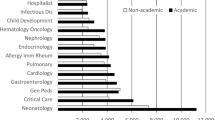Abstract
OBJECTIVE: To characterize and predict personnel time inputs to neonatal intensive care using infant characteristics from chart review.
STUDY DESIGN: For 12 hours each day, observers timed all direct care, charting, discussions, and procedures for 154 infants. Time inputs were correlated with 40 infant characteristics and resource markers, as well as the Score for Neonatal Acute Physiology (SNAP) for that day of care.
RESULTS: Nurses accounted for 76%, respiratory therapists 8%, fellows 5%, nurse practitioners 7% and attendings 5% of total time invested in patient care. Nurses and respiratory therapists spent proportionately more time in direct patient care. In regression models, a limited number of variables explained 36% of the variance in time input per patient for respiratory therapists (p<0.0001), 42% for nurses (p<0.0001), and 23% for physicians and nurse practitioners (p<0.0001).
CONCLUSIONS: Total labor inputs can be accurately predicted through the use of a limited number of clinical characteristics. This technique should be routinely employed to improve the accuracy of economic evaluations. Nursing accounts for the majority of time invested in neonatal care. Improved efficiency in neonatology is thus most likely to be generated by interventions that reduce direct nursing time.
This is a preview of subscription content, access via your institution
Access options
Subscribe to this journal
Receive 12 print issues and online access
$259.00 per year
only $21.58 per issue
Buy this article
- Purchase on Springer Link
- Instant access to full article PDF
Prices may be subject to local taxes which are calculated during checkout



Similar content being viewed by others
References
Khoshnood B, Lee KS, Corpuz M, Koetting M, Hsieh HI, Kim BI . Models for determining cost of care and length of stay in neonatal intensive care units Int J Technol Assess Health Care 1996 12: 1 62–71
Ewald U . What is the actual cost of neonatal intensive care? Int J Technol Assess Health Care 1991 7: Suppl 1 155–61
Rogowski J . Cost-effectiveness of care for very low birth weight infants Pediatrics 1998 102: 1 Pt 1 35–43
Rogowski J . Measuring the cost of neonatal and perinatal care Pediatrics 1999 103: 1 Suppl E 329–5
Richardson DK, Gray JE, McCormick MC, Workman K, Goldmann DA . Score for Neonatal Acute Physiology: a physiologic severity index for neonatal intensive care Pediatrics 1993 91: 3 617–23
Gray JE, Richardson DK, McCormick MC, Workman-Daniels K, Goldmann DA . Neonatal therapeutic intervention scoring system: a therapy-based severity-of-illness index Pediatrics 1992 90: 4 561–7
Zupancic JA, Richardson DK, Lee K, McCormick MC . Economics of prematurity in the era of managed care Clin Perinatol 2000 27: 2 483–97
Richardson DK, Zupancic JA, Escobar GJ, Ogino M, Pursley DM, Mugford M . A critical review of cost reduction in neonatal intensive care: I. The structure of costs J Perinatol 2001 21: 2 107–15
Richardson DK, Zupancic JA, Escobar GJ, Ogino M, Pursley DM, Mugford M . A critical review of cost reduction in neonatal intensive care: II. Strategies for reduction J Perinatol 2001 21: 2 121–7
Mugford M . The cost of neonatal care: reviewing the evidence Soz Praventivmed 1995 40: 6 361–8
Zupancic JAF, Richardson DK . Systematic review of neonatal randomized controlled trials reveals paucity of ancillary economic evaluations [Abstract] Pediatr Res 2001 49: 4 364A
The ECSURF (Economic Evaluation of Surfactant) Collaborative Study Group. Limited comparability of classifications of levels of neonatal care in UK units Arch Dis Child Fetal Neonatal Ed 1998 78: 3 F179–84
Tyson JE, Clarkson JE, Sinclair JC, Leitch R . Analysis of newborn intensive care by time-lapse photography Crit Care Med 1981 9: 11 780–4
Williams S, Whelan A, Weindling AM, Cooke RW . Nursing staff requirements for neonatal intensive care Arch Dis Child 1993 68: 5 Spec No 534–8
Northern Neonatal Network. Measuring neonatal nursing workload Arch Dis Child 1993 68: 5 Spec No 539–43
Acknowledgements
The authors gratefully acknowledge the assistance of Shawn Stewart, who assisted with data analysis, and of Ashish Shah, James Godin, and Christine Bumatay, who performed the personnel observations and chart abstraction while participating in the summer student program of the Division of Newborn Medicine, Harvard Medical School. We are also indebted to the nurses, respiratory therapists, staff, and administration of the neonatal intensive care unit of the Beth Israel Deaconess Medical Center for their enthusiastic facilitation of the data collection.
Author information
Authors and Affiliations
Additional information
Financial Support
J. A. F. Z. was supported in part by a Clinician-Scientist Award from the Medical Research Council of Canada.
Rights and permissions
About this article
Cite this article
Zupancic, J., Richardson, D. Characterization of Neonatal Personnel Time Inputs and Prediction From Clinical Variables — A Time and Motion Study. J Perinatol 22, 658–663 (2002). https://doi.org/10.1038/sj.jp.7210821
Published:
Issue Date:
DOI: https://doi.org/10.1038/sj.jp.7210821
This article is cited by
-
A systematic review of neonatal treatment intensity scores and their potential application in low-resource setting hospitals for predicting mortality, morbidity and estimating resource use
Systematic Reviews (2017)
-
Making Sense of Suffering and Death: How Health Care Providers’ Construct Meanings in a Neonatal Intensive Care Unit
Journal of Religion and Health (2006)


